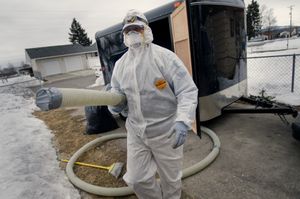Dunshee’s bond proposal: how to pay for it is largely still to be determined — and state treasurer is leery…
Rep. Hans Dunshee has proposed House Bill 2334, which would raise $3 billion for construction/renovation work on public buildings around the state. Voters would have to approve it first. The money would mostly go toward work on schools, from K-12 to the state's universities. It would pay for things like energy efficiency project, updating, etc.
(I posted a partial list, including locals, of which schools and colleges would benefit, and how many dollars they'd see. Click on the read-more link below for that list.)
How to pay for $3 billion in work? By issuing 20-year bonds, partly paid off by the $80 million in projected energy savings a year. (Of that, $40 million would go toward the debt, local schools/colleges/etc. would keep the rest.)
Still, that's only a small part of the $210 million a year in debt payments. Where would the rest come from? Maybe the operating budget, or maybe a new tax, Dunshee said. That part's still undetermined.
"We're going to fix schools, we're going to create jobs, and hopefully get the economy turned around a bit with this," said Dunshee, D-Snohomish.
Moments after Dunshee's announcement, however, state treasurer Jim McIntire sent out a press release saying that Dunshee's plan is too costly.
"The $3 billion of added debt called for in HB 2334 is too much," McIntire said in a press release a few minutes ago. "It would threaten our credit rating and would affect the rest of our investments in transportation and public infrastructure."
If the point is jobs, McIntire said, the plan should be scaled back. If the goal is longer-term construction on needed projects, he said, his office can help.
Where the money would go:
-$2 billion for school construction and renovation,
-$286 million for community and technical colleges,
-$79 million for the University of Washington,
-$46 million for Washington State University,
-$25 million for Western Washington University,
-$19 million for Eastern Washington University
-$19 million for Central Washington University,
-$9 million for the Evergreen State College,
-$500 million for energy efficiency improvements to public buildings, up to $200 million of which would go to such projects in K-12 schools and colleges. Half the resulting energy savings would go back into the account that pays for these projects.
Locally, the plan would mean $56 million for Spokane-area schools.
Other examples of local dollars:
-Cheney: $7 million
-Chewelah: $2.1 million
-Colfax: $1.4 millon
-Davenport: $1.2 million
-Deer Park: $5 million
-Kettle Falls: $1.6 million
-Medical Lake: $4.2 million
-Nine Mile Falls: $3.4 million
-Pullman: $4.6 million
